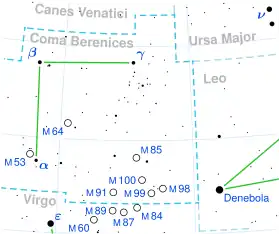11 Comae Berenices
11 Comae Berenices is a binary star[3] system in the northern constellation of Coma Berenices, located in the sky, east and slightly north of Denebola in Leo, but not nearly as far east as ε Virginis in Virgo. It is about a degree from the elliptical galaxy M85 and two degrees north of the spiral galaxy M100. Based upon an annual parallax shift of 10.7104 mas, the star is located 305 light years away from the Sun. It is visible to the naked eye as a faint, orange-hued star with an apparent visual magnitude of 4.72.[2] This body is moving away from the Sun with a heliocentric radial velocity of +44 km/s.[2]
 | |
| Observation data Epoch J2000 Equinox J2000 | |
|---|---|
| Constellation | Coma Berenices |
| Right ascension | 12h 20m 43.025580s[1] |
| Declination | +17° 47′ 34.3393″[1] |
| Apparent magnitude (V) | 4.72[2] (4.89 + 12.9)[3] |
| Characteristics | |
| Spectral type | K0 III[4] or G8+ III Fe-1[5] |
| B−V color index | 1.010±0.001[2] |
| Astrometry | |
| Radial velocity (Rv) | 43.6±0.2[2] km/s |
| Proper motion (μ) | RA: −109.241[1] mas/yr Dec.: +88.170[1] mas/yr |
| Parallax (π) | 10.7104 ± 0.2197 mas[1] |
| Distance | 305 ± 6 ly (93 ± 2 pc) |
| Absolute magnitude (MV) | −0.02[2] |
| Details[6] | |
| Mass | 1.66±0.21 M☉ |
| Radius | 15.781±0.3444[4] R☉ |
| Luminosity | 109.51±4.3256[4] L☉ |
| Surface gravity (log g) | 2.38±0.06 cgs |
| Temperature | 4,670±10 K |
| Metallicity [Fe/H] | −0.51±0.02 dex |
| Age | 1.53±0.54 Gyr |
| Other designations | |
| Database references | |
| SIMBAD | data |
The primary component is an aging K-type giant star with a stellar classification of K0 III.[4] It is a low metallicity star with an iron abundance about half that of the Sun.[4] Keenan and McNeil (1989) found a class of G8+ III Fe-1,[5] showing an underabundance of iron in the spectrum. At the age of 1.5 billion years old with 1.7[6] times the mass of the Sun, it has exhausted the hydrogen at its core and expanded to 15.8 times the Sun's radius. The star is radiating 110[4] times the luminosity of the Sun from its swollen photosphere at an effective temperature of 4,670 K.[6] It has a magnitude 12.9 companion star at an angular separation of 8.8″ along a position angle of 44°, as of 2007.[8]
Planetary system
A substellar companion was discovered orbiting the primary star in 2007 using the radial velocity method. It has a period of 326 days with minimum mass of about 19.4 Jupiter masses and is orbiting around 1.3 AU from the host star with an eccentricity of 0.23. The object's mass is well within the range of deuterium-fusing brown dwarfs.[9][10]
| Companion | Mass | Semimajor axis (AU) | Orbital period | Eccentricity | Discovery year |
| b | ≥19.4±1.5 MJ | 1.29±0.05 | 326.03±0.32 days | 0.231±0.005 | 2007 |
References
- Brown, A. G. A.; et al. (Gaia collaboration) (August 2018). "Gaia Data Release 2: Summary of the contents and survey properties". Astronomy & Astrophysics. 616. A1. arXiv:1804.09365. Bibcode:2018A&A...616A...1G. doi:10.1051/0004-6361/201833051. Gaia DR2 record for this source at VizieR.
- Anderson, E.; Francis, Ch. (2012). "XHIP: An extended hipparcos compilation". Astronomy Letters. 38 (5): 331. arXiv:1108.4971. Bibcode:2012AstL...38..331A. doi:10.1134/S1063773712050015. S2CID 119257644.
- Eggleton, P. P.; Tokovinin, A. A. (September 2008). "A catalogue of multiplicity among bright stellar systems". Monthly Notices of the Royal Astronomical Society. 389 (2): 869–879. arXiv:0806.2878. Bibcode:2008MNRAS.389..869E. doi:10.1111/j.1365-2966.2008.13596.x. S2CID 14878976.
- von Braun, Kaspar; et al. (2014). "Stellar diameters and temperatures – V. 11 newly characterized exoplanet host stars". Monthly Notices of the Royal Astronomical Society. 438 (3): 2413–2425. arXiv:1312.1792. Bibcode:2014MNRAS.438.2413V. doi:10.1093/mnras/stt2360. S2CID 275132.
- Keenan, Philip C.; McNeil, Raymond C. (1989). "The Perkins catalog of revised MK types for the cooler stars". Astrophysical Journal Supplement Series. 71: 245. Bibcode:1989ApJS...71..245K. doi:10.1086/191373. ISSN 0067-0049.
- Jofré, E.; et al. (2015). "Stellar parameters and chemical abundances of 223 evolved stars with and without planets". Astronomy & Astrophysics. 574: A50. arXiv:1410.6422. Bibcode:2015A&A...574A..50J. doi:10.1051/0004-6361/201424474. S2CID 53666931.
- "* 11 Com". SIMBAD. Centre de données astronomiques de Strasbourg. Retrieved 8 September 2012.
- Mason, B. D.; et al. (2014). "The Washington Visual Double Star Catalog". The Astronomical Journal. 122 (6): 3466. Bibcode:2001AJ....122.3466M. doi:10.1086/323920.
- Liu, Y.-J.; et al. (2008). "A Substellar Companion to the Intermediate-Mass Giant 11 Comae". The Astrophysical Journal. 672 (1): 553–557. arXiv:0709.0645. Bibcode:2008ApJ...672..553L. doi:10.1086/523297. S2CID 18039163.
- "Planet 11 Com b". The Extrasolar Planet Encyclopedia.